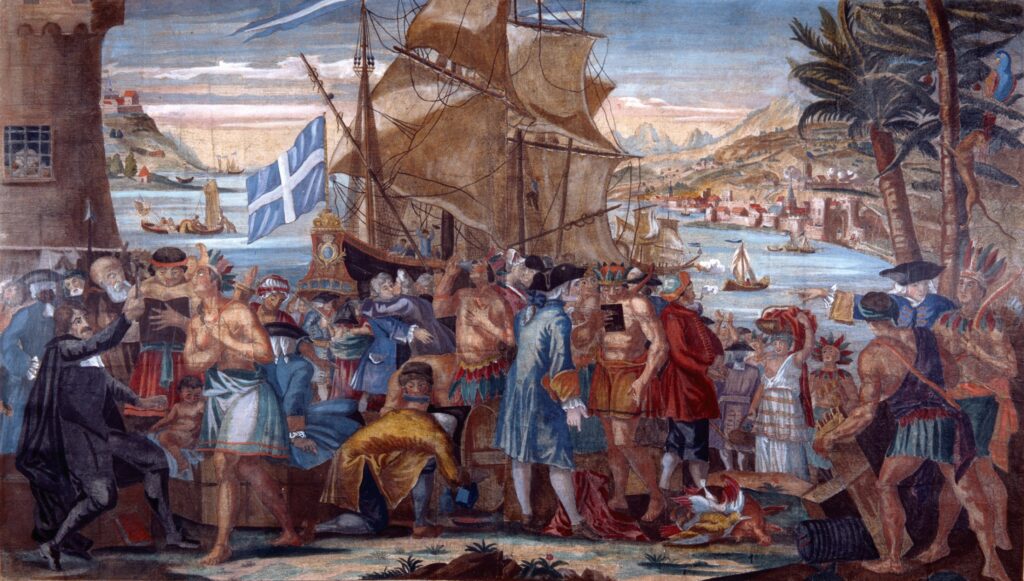Money, a core subject of financial economics, is a human invention created to facilitate the functioning of the real economy market and is one of the social technologies. Haven’t fire, the wheel, and money been called the three great inventions of mankind? It’s hard to imagine an economy without money. The financial economy, composed of money, is essentially a part of the real economy.
However, if the financial economy is forcibly separated from the real economy, only a world made up of money would remain. The money discussed here includes cash, checks, stocks, bonds, derivatives, and everything else used for transactions or value storage. These are artificially created by humans and are essentially based on promises. The moment these promises are broken, their value disappears. If people’s promises are not reliable, then the financial economy, independent of the real economy, can always become an illusion.
The Reason Columbus Went West
Why did Columbus risk the sea? In school, we learn it was because of a spirit of adventure towards a new world. But the reason he took the risk was because of money. The contract he had with Queen Isabella of Spain at the time shows this. According to the contract, Columbus could become the lord of the lands he discovered and own one-tenth of the wealth obtained there. Isabella was the venture capitalist, and Columbus was the venture entrepreneur.

Columbus might have been convinced he could become wealthy because he read the stories of gold recorded by Marco Polo in his “Travels”. The original title of the book is “The Description of the World”. In it, Marco Polo wrote that “the island nation of Cipangu, east of China, is so rich in gold that even the palaces have walls made of gold”. Cipangu refers to what is today Japan. It seems Marco Polo used his imagination as well as what he saw to write his “Travels”. Regardless, it was the gold that prompted Columbus to set sail west from the port of Palos in Spain on August 3, 1492.
The Birth of Currency
Marco Polo might have spoken about the glittering ‘gold,’ but what Columbus saw here was money, because the money that drove the European economy was made of gold and silver. It is said that Columbus, during his exploration of the New World in 1503, sent a letter from Jamaica in South America that contained the following passage:
“Gold is a treasure, and he who possesses it does all he wishes to in this world, and succeeds in helping souls into paradise.”
The gold mentioned here refers to money in an economic sense. Indeed, the motivation for many Europeans, including Columbus, to venture into the New World was money. Gold from Africa and the Americas was directly money in Europe.
By that time, the gold mines in Europe and Arabian territories were starting to deplete. Portugal first turned its attention to Ceuta, a port facing Europe across the Mediterranean at the end of the African continent. Ceuta was a strategic point for trade involving gold, ivory, and slaves coming through the Sahara Desert trade routes. Under the command of Prince Henry (also known as Enrique or Henrique), Portugal conquered Ceuta and established its own gold bullion manufacturing facility there.
However, metallic currency made of gold and silver had many inconveniences, such as being difficult to carry and being at risk of theft. The transaction costs were high. This led to the early use of paper money in China, although it was discontinued due to inflation. In Europe, the Bank of Venice introduced paper money in 1587 as the first in Europe, but it did not last long.
Against this historical backdrop, in 1609, the Netherlands issued paper money that could be exchanged for gold. Each banknote was essentially a receipt for gold stored in the bank. This currency is the Dutch guilder that is still in use today. It was possible because people trusted the Bank of Amsterdam and its commerce. How could anyone be sure that the bank had the same amount of gold as it issued in paper money? Regardless, people believed that the banknotes held the same value as gold and preferred them over carrying gold bullion, as seen in Caribbean pirates. In fact, at one point, these banknotes were traded at a premium of more than 3% over the corresponding amount of gold, acknowledging the value they provided by reducing transaction costs in the market.
The Netherlands eventually dominated European commercial trade for 100 years from 1600, benefiting from being a commercial hub with a reliable and convenient currency. At one time, this small country managed over 50% of Europe’s trade volume, generating substantial profits. The use of banknotes laid the foundation for the development of stock exchanges, banks, and securities. Even Spain, which could be considered an enemy state, used the Dutch financial market, indicating a high level of trust.
It might seem obvious now, but replacing gold coins with paper money was not a simple idea.
There was someone who had an even more revolutionary idea than the Dutch banknotes. John Law from Scotland, the first to issue inconvertible paper money, which means banknotes that could not be exchanged for gold. John Law was a financier’s son, an economist who traveled through several European cities, earning money through gambling. He likely closely observed and analyzed the Dutch guilder. Then, he conceived the idea of issuing paper money that did not need to be exchanged for gold. However, as he traveled across Europe, no country was willing to listen to his idea. After many difficulties, he finally got the opportunity to test his idea in France.
At that time, Europe was in a period where the economic size was growing, but there was a shortage of gold to make currency. With a lack of money, market transactions decreased, leading to reduced production and jobs, and the economy stagnated. Especially France, under Louis XIV, struggled with growing fiscal deficits due to wars fought against several European countries and the construction of the Palace of Versailles, among other extravagances. John Law met the Duke of Orléans, who became the regent for the French king after Louis XIV’s death. They quickly found common ground, thinking that they could easily settle the massive national debt by printing money. John Law thus received a private bank’s license to issue banknotes from the French monarchy.

John Law immediately began issuing currency backed by the supposed gold buried in the land of Louisiana, a French colony in the west of the Mississippi. Whether or not there was gold underground in Louisiana was not important; what mattered was whether people believed it. Indeed, the Bourbon monarchy of France managed to handle the royal family’s debts since the reign of Louis XIV with this money, and John Law himself became wealthy, revitalizing the French economy. John Law’s private bank was soon promoted to a royal bank.
However, the problem was once again inflation. As the issuance of banknotes excessively increased, inflation was triggered, and people began demanding their banknotes be exchanged for gold. At that time, John Law had no means to provide gold buried in Louisiana. By the end of 1720, the Louisiana myth had faded, and France, experiencing economic instability and difficulties, was moving towards the French Revolution of 1789. This event also led to a preference in France for using the term ‘Credit’ over ‘Banque’ in the names of financial institutions, such as the Banque Nationale de Paris and Crédit Lyonnais.
Although it ended tragically, John Law’s attempt left several lessons. First, it showed the possibility of fiat money, not backed by gold, though it took about 200 years to be realized. Second, it taught that if the right to issue money is entrusted to the government or the king, there could be an overproduction of money as needed. Therefore, European banks maintained a private banking form, and even when nationalized, it was understood that central banks should operate independently from the government as much as possible.
The Bank of England, a private bank founded in 1694 by William Paterson with the exclusive right to issue money in return for lending 1.2 million pounds to the British government, was nationalized in 1946. The Bank of France, established by Napoleon in 1800, was nationalized in 1936. Meanwhile, the central bank of the United States still formally has private banks as shareholders. The book “Currency Wars” published in China and the documentary film “Zeitgeist,” widespread on the internet mainly in the United States, argue that international financial capital forces have conspired behind major global events over the past 300 years, including the global financial crisis not being an exception.
Governments in the US and Europe, without the authority to issue currency, had no choice but to borrow money from banks for war expenses, thus becoming subject to the control of the real owners of central banks, the international financial capital forces. This power has allegedly dominated the world economy invisibly since the Battle of Waterloo, with events such as World Wars I and II, the Great Depression of 1929, the oil crisis of the 1970s, George Soros’ attack on the British pound in 1992, the Asian financial crisis of 1997, and Japan’s lost decade, all being linked to conspiracies by these forces. However, it’s essential to understand that central banks were initially created to check on the government’s unilateral issuance of currency, acknowledging that banking indeed was a profitable business.
After the Great Depression, the US Congress passed the Banking Act of 1933, which separated commercial banking from investment banking and allowed government bonds to be used as collateral for currency issued by the central bank. President Roosevelt at that time also collected all gold and silver certificates, effectively declaring the end of the gold standard.
On the other hand, some argue for a return to the gold standard, citing the instability of today’s currency. However, it is questionable whether conditions allow for a return to the gold standard era, considering the rapid annual increase in global trade volume. Gold is indeed the most reliable currency, but the problem is that not much gold exists on Earth. It’s estimated that about 150,000 tons of gold have been mined from the Earth so far, with about 22,000 tons used for industrial purposes and disappeared. Of the remaining 128,000 tons, a quarter is officially stored as gold bullion, and three-quarters, or 96,000 tons, are owned by individuals. If all the gold existing were evenly distributed among the global population, each person would get less than 20 grams. If the gold were made into rings, it would only be enough to give each person a ring weighing about 5 grams. To use gold as currency, more gold would have to be mined, or the value of gold would have to skyrocket.

